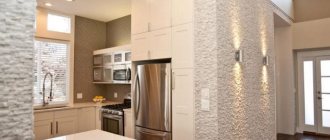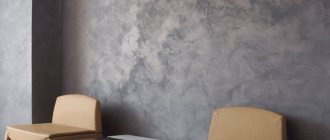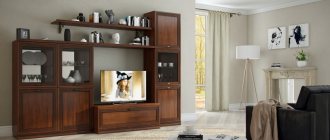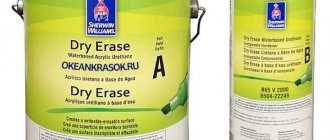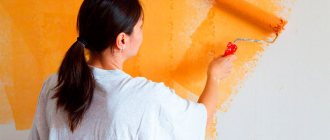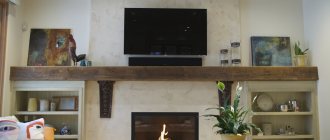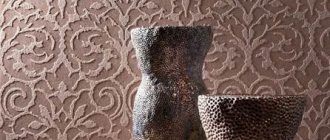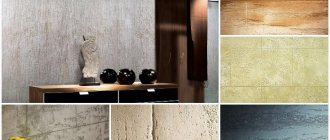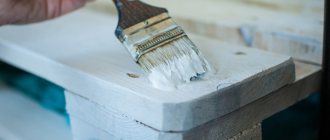If you need to create a unique interior, but ordinary wallpaper seems banal, decorative sand plaster will help solve the problem. This is a new approach using proven technologies over the years.
Plastering is used in finishing work to level walls and ceilings. With the help of mixtures, cracks are eliminated and height differences are compensated, and the adhesion between the wall and the finish is increased. However, the emergence of new compositions has made it possible to expand the possibilities of plaster and create original types of decor.
Sand paint composition
The main ingredients included in the composition are binders, solvent and antiseptic additives that prevent the formation of fungus and mold.
To create an interesting texture, crushed shells, quartz sand, mother-of-pearl chips or other mineral components are added to the paint mixture. Such additives allow you to achieve a textured effect.
Sand paints are thicker, so they can mask minor wall defects. This saves time and money on plastering surfaces.
Main types
Decorative sand-effect wall paint is produced in a wide range of shades. On sale are not only compositions of the main color palette, but also paints that imitate a metal surface - bronze, silver, gold. If desired, you can order the white paint to be tinted in the shade you need.
There are two main types of paint mixtures:
- Mother of pearl. They contain reflective components that give the coating a pearlescent shine. If you look at the surface of the walls from different angles, the paint may change shade. If you liked this option, then perhaps you will also like silk paint for walls.
- Matte. No fillers that reflect light are added to such mixtures. This look is great for decorating walls in soothing colors. The surface has a rough texture.
The high strength qualities of sand paints make it possible to use them for both interior and exterior work. The considerable cost of a facade painted with such compositions is paid off by the long service life of the coating and its magnificent appearance.
Composition and effects
There are two main divisions of decorative plaster “sand” - matte and pearlescent. When walls are painted with mother-of-pearl coating, they acquire a silky and smooth feel. Thanks to the reflective particles in the pearlescent plaster, the finished walls shimmer in shades close to the base. The main reflective particles are crushed shells and various sparkles.
If you choose cheaper material, you can highlight brands such as Bayramix, Descartes, Elitas and others. And if a little more expensive, then “Veneziano”, “Baldini”, “Adicolor”. In terms of quality, one category is not much different from another; here everyone chooses according to their taste and composition.
Effects:
Sand dunes . Basically, this treatment is used if you want to depict a Moroccan or oriental style, since the wall turns out to be shimmering. As a rule, pearlescent paint is used in this technique.
Sandy winds . This effect is created due to the double layer of decorative plaster. The important thing here is to apply the layers in wide sweeping movements, crossing strokes with each other, drawing swirls. After drying, you should sand the surface so that the color becomes richer.
Pebbled leather effect . To create this effect, you need to resort to using a stencil (when you apply the second layer). Sanding is also recommended.
Burlap effect . You can achieve it by working with a small bristle brush. How much to manifest is up to you to choose.
How to apply
The application technique is not too complicated, but requires care and careful adherence to the manufacturer's instructions. First you need to prepare the surface.
Preparation consists of several operations:
- Cleaning the base from dust, dirt, grease and oil stains. If this is not done, then the adhesion (adhesion) of the paint to the surface may be insufficient, which will significantly deteriorate the strength qualities of the decorative layer.
- Removing crumbling plaster. Durable plaster does not need to be removed.
- Plastering the surface. Both cement and gypsum compositions can be used. Gypsum plaster dries faster; it is advisable to use it if finishing work needs to be completed in a short time.
- Puttying. At this stage, minor defects in the walls are repaired and the surface is finally leveled. Final leveling is carried out using a sanding block.
- Application of deep penetration primer. The primer is applied to clean, smooth walls.
Proper preparation of the base will ensure a long service life of the decorative coating.
Methods for applying paint with sand are chosen depending on what texture you want to get as a result. Usually the paint is sold ready for use, only sometimes it needs to be diluted a little with water.
The first layer is done using a paint roller, fur or thread. The layer thickness varies from 1 to 3 mm.
There are variations of this stage among different masters. Most often, the base is applied with non-textured paint, tinted in a color close to decorative paint. Some craftsmen simply tint the primer.
The second layer, which actually gives the effect, is applied with a brush after the first has dried. Then the coating, preventing it from drying out, is smoothed with special tools, most often with a brush - dispersing sand over the surface, decorating it. If the walls should have a pronounced relief, you can use a roller with a fine structure.
If you haven't worked with sugar paint before, try doing the whole process on a small test surface first. How the master does it in the video.
The painted surface dries for at least a day; you can decorate the walls with interior items only after it has completely dried.
What effect can you achieve?
"Shagreen skin"
It's easy to get. A distinctive point is the ability to use on uneven surfaces . When alternative methods become powerless, plaster with the “Shagreen skin” effect can come to the rescue. Minor roughness is hidden due to the non-uniform pattern. Sometimes even a smooth effect is created.
Plasters with this effect are applied as a final layer. Other options are not considered, since it will not look beautiful under other layers of finishing coatings. Depending on the characteristics of the room, stylistic design, lighting and area, the selection of paint, its quantity, and unusual pattern is carried out.
"Sackcloth"
- To achieve this effect, you need to prime and putty the surface. You will need a new medium-sized roller onto which the composition will be applied.
- When the putty dries, begin mixing the mass. Take finishing putty, water and PVA glue. All these ingredients will give plasticity to the cladding and quickly adhere to the wall.
AdviceTo get the burlap effect, you need to apply the prepared solution to the wall in even portions and strictly in a vertical direction.
- The brush makes vertical furrows by evenly fixing the tool. The appearance of wavy areas must be avoided.
- After the first layer has completely dried, a second one is applied, but in a horizontal direction. Layers also need to be applied in stripes. Here furrows are made again, but horizontally.
- After drying, the putty is passed over the surface with sandpaper - all irregularities and bumps will be eliminated.
- The last stage on the way to obtaining the desired design is priming and painting the walls.
The beautiful relief surface looks very good against the background of any interior.
"Sand Dunes"
"Sand dunes" are created with a brush . The drawing is associated with the desert. The ways to create a masterpiece come down to the following steps:
- Cross-shaped strokes are applied: the hands are moved from side to side. Place the brush at a gentle angle, and use a spatula as a tool.
- Allow the applied layers to dry and at the same time examine the surface for possible defects. If omissions are found, then you should immediately apply a new layer to the defect.
- Blend with a clean brush. Performed to give a careful appearance. Therefore, you should only use a new brush so as not to leave any traces of dirt.
- Increase density. Perform this step as needed. “Sand swirls” are complemented by another final layer of plaster, on which similar work is carried out. Allow this finishing layer to dry thoroughly and inspect it at the time of the gaps. All unfinished or missed points are corrected.
In the first 2–3 days, the pattern can be adjusted , since the adhesion of the wall to the putty occurs over the course of several days. After a week's break, this may not be possible. All work should be carried out clearly within the specified time frame and at a certain interval to correct defects.
"Sand Wind"
A pattern similar to the first one, differing only in that it is performed according to a chaotic swirl application pattern. Circular movements are added to the cross movements. It is important to notice the style and assertiveness of the movements in order to recreate the desired visual picture.
Advice
The material should be scattered over the entire surface of the wall, including the recesses, if any. The brush should not be dipped into the container too much, nor should it be overloaded with material, in order to prevent it from becoming tacky and excessively piling up.
The resulting pattern depends on the application technique. The easiest way is to spray . You need to dip a stiff brush into the mixture, and then hit the board with the bristles at a short distance from the wall. Splashes will fly onto the surface, and after drying a pattern will appear.
It is more difficult to work with a spatula. But without it it will not be possible to create a surface with the effect of a “sand dune” or “wind”. Movements can be made in one direction or crosswise.
To work, you need to have several brushes, purchased recently, and not already used. After the procedure has been completed, the sand is shaded with a new brush in the same direction. If there are areas without plaster, this area is passed through with the tool again. Sometimes it may take longer to apply a few more coats.
A layered painting can look completely different . Everyone chooses the type and quality of work done, which will depend on what they need to get. You can add more layer-by-layer filling, but it will look very pretentious, although sometimes it can be advantageous.
Advantages of sand-based paints
Sand paint compositions are water-soluble paints, so they are easy to apply. Stains that accidentally end up on the floor can be easily cleaned without using solvents.
- High adhesion. Good adhesion to the prepared base ensures a long service life of the coating.
- Ecological cleanliness. The ingredients contained in the paint will not harm health, so it can even be used in children's rooms.
- Immunity to mold and fungi, as antiseptic additives are added to the mixture.
- At the base preparation stage, there is no need to use finishing putty, which reduces the cost of preparatory work.
- Simple application process. Even an inexperienced craftsman can paint walls with sand paint.
- Durability and abrasion resistance. Correctly applied paint ensures the service life of the decorative coating up to 10 years.
- Fade resistant. The finish retains its original shade and stylish appearance throughout the entire period of use.
Properties
Decorative paint with sand effect has many advantages that even picky buyers simply cannot help but like:
- Walls covered with such a mixture will delight household members for many years, since the rough paint is considered very durable. According to many experts, you won’t have to repaint the walls for up to ten years.
- Sand paint is considered universal in many respects. It is ideal for painting walls in any room, including the kitchen, living room and bedroom. In addition, such decorative plaster is not at all afraid of moisture, which is why many designers choose it for painting walls in bathrooms.
- Due to its excellent properties and characteristics, the paint will not need to be regularly updated and additionally taken care of. In addition, it is believed that walls with such finishing are not as dirty as those on which wallpaper is glued.
- Most brands offer only high-quality decorative paints that do not contain synthetic substances or any harmful or toxic components. They cannot harm the health of others.
- Thanks to the perfectly selected composition, mold will not grow on painted surfaces. In addition, it will not be difficult for you to wash the paint after work, because all you need is plain water.
- Decorative paint is also very relevant due to the fact that when it is distributed on the wall, no joints will form, resulting in a solid picture that will please your eye.
Despite all the positive properties of the decorative coating, its minor disadvantages include the fact that before distributing the mixture on the wall, it will have to be carefully prepared. This is done for the best adhesion of the material to the wall.
Today, many domestic and foreign brands can offer a lot of different painting options for walls. To have a more detailed idea of what sand effect paint looks like, you should consider its main varieties.
Decorative paint for painting walls with a sand effect is:
- Mother of pearl. The mixture with mother-of-pearl contains special components that give it a special shimmer and shine. High-quality paints of this type are considered completely safe for humans and the environment, since they do not contain any harmful components or additives.
Basically, this kind of building materials are more expensive than conventional ones. This depends on the fact that they may contain real ingredients that are obtained from sea shells, as a result of which such mother of pearl is most valued. Options with quartz sand are also highly valued, as they look very unusual.
- Matte. This paint does not shine, but creates an unusual rough effect on the walls, which looks very advantageous in many modern interiors. Be sure to pay attention to matte options with white sand, they are ideal for very spacious rooms.
Both pearlescent and matte varieties have a very good texture, which spreads over the walls without problems and does not cause unnecessary problems even when painting it yourself. In general, their manufacturing technology is no different.
In addition to the main varieties of paint of this type, it can be found in a wide variety of colors and shades, but if you want to get something unusual, then feel free to purchase several options and mix them. This method will allow you to get an individual color of sand paint.
Among the large assortment you can also find unusual colors with splashes.
Walls with decorative sand-like plaster in interior design
Decorative plaster with sand is suitable for any interior. The main thing is to choose the right drawing. In the hallway and corridor in the apartment, you can choose a light finishing material and make a classic spray. It will look more impressive than regular wallpaper.
Today, African interiors are incredibly popular. To create them, you simply need such plaster. For example, in the living room you can create imitation leather on one of the walls. African vases and masks against its background will look very impressive. It is also possible to decorate such an interior with plaster that imitates sand in the desert, on top of which you can hang photographs of African landscapes.
Plaster that imitates leather or cracked terracotta earth is ideal for an African interior.
Plaster with sand will fit into a rustic interior; it is also suitable for Provence. For such interiors, the structural material should not be too complex. It is desirable that there are no flickering particles in it. Choose plaster of sand, olive, beige, cream colors - they are ideal for these styles. Those who love a rich oriental style are advised to take a closer look at plaster with a large amount of quartz sand. Additionally, it must be treated with bronze, copper or gold paint. The corresponding accessories are also selected to match the color of the walls: pillows in golden pillowcases, candlesticks and gilded lamps.
Plaster with gold and bronze inclusions is ideal for creating classic interiors. It looks rich and presentable.
White plaster with a pearl tint is suitable for an office. This color will visually expand the space and make the interior more airy. Furniture made of wood, glass and plastic will look good against the background of light plaster. It is impossible to imagine an Italian-style interior without the use of Venetian plaster. It is suitable for both the living room and the bedroom. The material with this effect has a noble shine. It is noticeable only in certain lighting, thanks to which a chamber atmosphere is created in the room. Paintings in gold frames, crystal candlesticks, expensive wooden furniture and long-pile carpets will help complement the interior.
Plaster with sand is not suitable for all modern interior styles. For example, it will fit perfectly into a loft: using a gray substance you can create a cement “coat” on the walls. But such a finishing material is not suitable for Scandinavian interiors or high-tech rooms.
Decorative plaster with sand has several advantages over conventional wallpaper. With the right choice of pattern, it can be used to decorate interiors of different styles: from African and oriental to classic and rustic. Even a person without special training can cope with applying plaster to walls. And even if the mixture does not lie perfectly, it’s not scary. Flaws in the work can be passed off as a decorative technique.
How to choose?
If you want to see beautiful and shimmering walls in your interior every day, then boldly choose sandy pearlescent paint with a radiance effect, which is available in a variety of shades. With this mixture you can get an unusual velvet effect on the walls.
You should choose paints only from trusted manufacturers. In addition, high-quality options have fairly low paint consumption, which will help save buyers from additional expenses. You can choose paint for application not only on walls, but also on the ceiling. The consistency will be absolutely no different.
Creating patterns
Although patterns in general seem intricate and unpredictable, professionals certainly know how to achieve a specific type of pattern. Those who want to make repairs themselves also have the right to know this.
Sand swirls on the wall are perhaps the most popular motif in modern renovations. To achieve this effect, you usually have to plaster the wall in two layers, of which the first is the main one, and the second is a decorative layer. “Storm” is created on the wall with wide cross-shaped strokes, and for greater spectacle it is recommended to choose plaster for these purposes in similar, but still slightly different tones. The dried surface must be sanded, otherwise the finish will look more like dirt than a work of art.
When executed correctly, this design will be a good addition to classic design styles.
Many people associate sand with the desert, so dunes created using decorative sand plaster are also in great demand. To create this effect, the plaster is applied in the same way as in any other case, but an additional step is required - opening the dried surface with a special pearlescent paste. This mixture increases the shine of the quartz particles in the plaster, making the wall seem truly made of sand.
There are no strict restrictions regarding the use of such an effect in the interior, but it would look especially impressive in combination with some ethno-style: primarily with the African or Mexican design of the entire room.
Finally, quite often customers, when choosing decorative “sand” plaster, want to end up with a wall that would resemble the alluvium of ordinary river sand. To create such a design, craftsmen usually resort to a fairly simple method: simply apply the mass to the wall in diagonal movements.
For a detailed master class on applying decorative plaster “Sand”, watch the video below.
What to prime with?
To properly prime the walls, first of all, they must be cleaned of all contaminants. It is very important that the walls are free of any stains or residues from previous coatings.
Sequence of actions:
- To prime the walls, ordinary plaster is used; it is best to choose one that is gypsum based, since it dries faster. Nevertheless, many buyers also purchase one that is produced on a cement base.
- For final leveling of the wall surface, putty is used. It is best to use one that is made on an acrylic basis. Acrylic putties very often have antibacterial properties, which is their big advantage.
- After applying plaster and putty, the surface must be leveled using a special sanding block.
- After carrying out all the preparatory procedures for priming, it is necessary to apply a special primer composition to the leveled walls, which can be purchased at hardware stores.
It is on such an ideally prepared wall base that decorative sand paint will last as long as possible.
Video
Below are master classes on applying plaster with sand. In the first video, the master creates two different textured surfaces: small crossing strokes and vertical stripes.
Next is a video tutorial on applying decor with sand under “shagreen leather”. The brush movements are not strokes, but pokes.
We hope that the article was useful to you. Leave your feedback and questions in the comments below.
Previous
Decorative plasterThe best ways to make a decorative brick wall from plaster
Next
Decorative plasterCrackelure: decorative plaster with cracks
How to apply?
You can even paint this type of wall yourself, since applying the paint does not require much effort.
To properly distribute sand paint on the walls, you need to follow a few instructions:
- To begin with, it is very important to prepare the paint correctly, according to the instructions that come with the kit.
- The resulting mixture should be applied using a roller (fur or thread), the layer thickness should not be more than three millimeters. The larger the layer, the denser the structure will be in the end.
Next, you need to wait until the layer you applied dries slightly and use a special fine-textured roller. It is used to make the paint rise a little and create a kind of relief.
- You also need to use a regular wallpaper spatula, with which you should lightly press down the surface. You can do this in different directions, as you like best.
After all the steps have been completed, the paint must be allowed to dry. It is advisable that 24 hours pass.
While the walls are drying, there should be no drafts in the room.
Manufacturing
Often the paint is sold ready-made, and before use you just need to mix it properly. However, in some cases, to prepare the desired consistency you have to dilute it with water.
You can create paint of an unusual color with your own hands. To do this, you will just need to buy several different colors and mix them together. It is best to choose options from the same manufacturer, otherwise the composition and consistency will differ.
Manufacturers and reviews
Among the many manufacturers that offer quality sand effect paints, Monaco and Mirage paints deserve special attention. Textured paint from a French manufacturer is available in a huge range of pearlescent colors. Many buyers leave good reviews about durable German interior wall paint Alpina.
Most buyers are satisfied with the quality of sand paints, since they apply well to walls, are applied without any problems and dry fairly quickly. Some say that pearlescent options look much better than regular matte ones.
In general, on the Internet you can find a lot of opinions from different buyers about paints of this type. You can find both positive and negative reviews about some manufacturers.
Examples
- Sand-effect wall paint harmonizes equally well with both classic and modern interior styles. The main thing is that the walls correspond to the overall design of the room, and do not contradict it.
- Using white, milky, cream and beige pearlescent paints with a sand effect, you can visually expand any space, make it lighter, more comfortable and spacious.
- Using sand paint you can decorate, for example, only one wall. Or zoning the room using different colors.
- Pearlescent paint colors can always fit very well into a Baroque or Rococo interior. Light gray matte shades or completely black will certainly complement the interior of a modern high-tech style.
- An unusual solution would be to decorate the walls with matte or pearlescent paint in the hallway. All shades of nude and chocolate color look great.
If you are not sure that you can independently choose the right shade of paint for the interior, as well as carry out finishing work, it is best to use the services of specialists.
To learn how to apply decorative paint for walls with a sand effect, see the following video.
When designing the interior of a room, you should not get hung up on the classic decoration with wallpaper or panels. Modern paints have a number of advantages, among which aesthetics is highly rated. The article will focus on decorative coating with a sand effect.
What is the solution?
Sand plaster for finishing work is a composition whose consistency is similar to wall paint. It combines the properties of plaster and paint, which allows the mixture to be used to create various design projects. Even a person without experience can work with such material.
Types of sand effect paints
The paint is available in two types:
• mother-of-pearl – the composition includes sparkling elements that shimmer on a rough surface depending on the angle of refraction of light;
• matte – does not create glare, its characteristics are similar to textured plaster.
Matte finishes look ideal in spacious rooms and give the interior lightness and airiness. Reflective particles of mother-of-pearl products visually expand the volume of a small room. Also, this type of paint brings luxury and high cost to the interior of historical styles.
The scope of application of decorative sand-effect coating is limited to interior finishing work.
Interior options
Ideas for interior design with this plaster finish:
- Terracotta effect of the fireplace area . The warmth of the fire is depicted over the entire height of the wall with tints in the texture of the finish.
- Bathroom decoration in a classic style . The calm, measured version of the interior looks chic and simple at the same time.
- Golden tone and forged stair elements . The sophistication and luxury of the texture is achieved due to the absence of bright and pretentious shades.
- Matte sand wall . Ideal in the living room, when decorating rooms in eco-style.
- Imitation of masonry from stone blocks . Country style will look great in a spacious hall or a spacious living room.
- The coating is characteristic and unambiguous - it is sand . The background in the interior here is created in pastel colors. Accessories and textiles, which are placed in the finishing area, play an important role.
We invite you to look at photos of interior options with decorative “sand” plaster.
Terracotta around the fireplace:
Decorative plaster “sand” in terracotta color in the interior:
Classic style bathroom:
Decorative plaster “matte sand wall in eco-style”:
Another interesting option for finishing with sand plaster:
Advantages and disadvantages
Before applying a decorative coating, you should evaluate all the pros and cons to avoid unpleasant surprises and cost overruns.
• versatility of the coating (to obtain a decorative effect, you do not need to purchase several types of materials, one paint is enough);
• preservation of color and texture during operation due to resistance to UV and other external factors;
• strength and wear resistance;
• the ability to tint with pigments to obtain the desired shade;
• long service life (the coating retains its presentable appearance for about 10 years);
• resistance to microbiological processes;
• high aesthetic indicators;
• easy maintenance (wet cleaning can be done).
The decorative coating has practically no disadvantages. The only important condition is the requirement to prepare the working surface for painting. Unlike decorative plaster, paint does not hide minor flaws on the wall. Therefore, during the preparation process it is necessary to pay special attention to leveling the planes.
Paint application technique
To achieve the desired result of wall finishing, it is necessary to follow a certain technology.
• Prepare the work surface to achieve perfect evenness and smoothness. For these purposes, it is recommended to use putty (starting and finishing) on a gypsum basis.
• After drying the walls, clean off excess putty with a special mesh.
• Treat the surfaces with a deep penetration primer in two layers. Instead of a second layer of primer, you can apply water-based paint to match the decorative coating.
• Applying the first layer of decorative paint with a roller. Using different techniques, surface texture is achieved.
• The second layer (composition with sand) must be applied with a brush. Without allowing the layer to dry, smooth the surface with a special tool (grater, spatula, trowel).
Selecting the necessary tools
To work with plaster that imitates sand, you will need a number of tools:
- scraper;
- spatulas of various sizes and purposes;
- trowel;
- grater;
- rollers of several sizes;
- brushes, combs and brushes;
- container for preparing the solution;
- drill with an attachment for mixing the composition.
There are various types of tools available in the market. It is better to give preference to stainless steel products. This will help avoid troubles associated with the appearance of yellowness on the composition.
Sand paint: interior solution
Sand effect paint is popular among designers as it suits any interior style. In addition to the fact that the coating itself is of aesthetic value, you can get different variations in texture and surface texture. This is achieved by using different methods of applying material to the wall.
Before purchasing paint, you need to decide on color schemes. The issue of texture is put in second place. The choice of color is carried out taking into account the characteristics of the room and interior style.
For the bathroom it is better to give preference to a white tone or shades of beige. Green walls change the tone of the skin, and blue can create a shading effect. If the bathroom has a large area, the question of color scheme disappears. With good lighting, any wall will look gorgeous.
The choice of paint for the kitchen is made taking into account the effect of color on appetite. Many people believe that bright colors stimulate hunger, so they refuse colorful interiors. Recommended tones by designers: gray, white, blue.
A blue tone is more suitable for the living room, and it doesn’t matter at all whether it is pearlescent or matte. The interior acquires airiness, lightness, and ease. Spending time with family or guests in such a room will be very comfortable. A salad living room or a multi-colored one, combining contrasting shades, looks no less interesting.
If the paint is selected to match the styles: baroque , classic, rococo, then preference should be given to mother-of-pearl coatings. Matte is more suitable for modern style.
